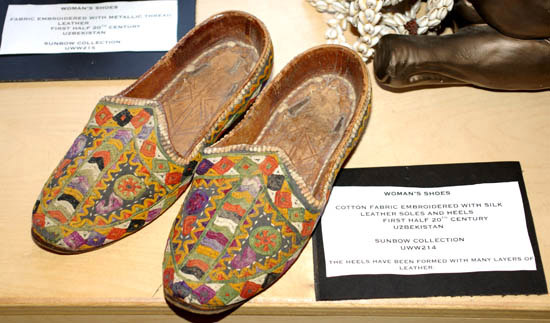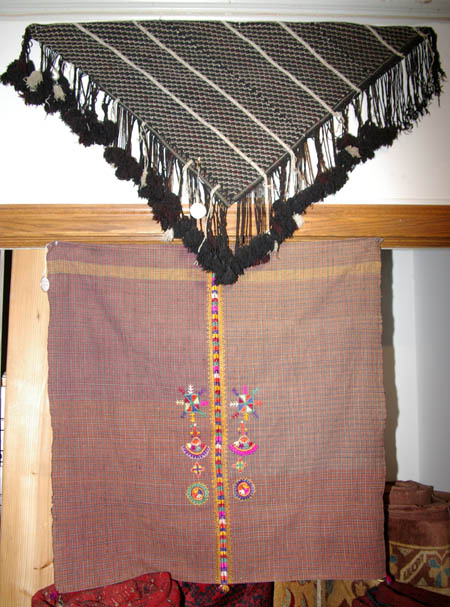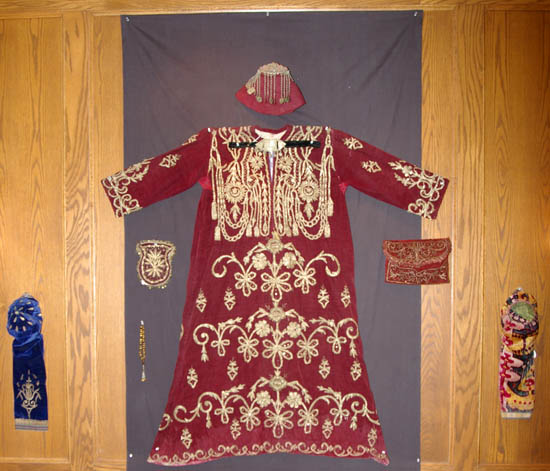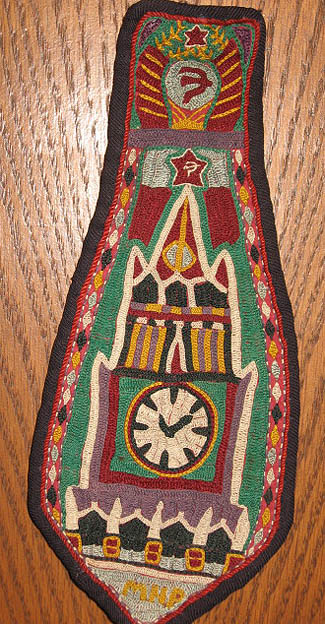Saul Barodofsky is a dealer, as most of you know, but is also a collector. His collection and his inventory are strictly segregated. Parts of his collection have been exhibited att the University of Virginia's Bayley Fine Art Museum, at other Virginia venues, and in his gallery. He has just opened one entitled, Arrayed in Splendour - Garbed in Glory: Traditional Clothing from the Peoples of the Old Silk Road, in his gallery (Sun Bow Trading Company, Charlottesville, Virginia). I was given a preview of the exhibition, and took the opportunity to photograph much of it. Saul kindly provided me with images of some pieces that had not yet been hung during my preview. Those are the last six photos on this page. None of the items that are shown here are for sale, although a few things that are for sale are included in the exhibition.
Here are the photos of the exhibition, in no particular order. They are numbered for convenience in discussion. The descriptions and commentary are mine, based mostly on Saul's notes.
Number 1: A pair of shepherd's robes or cloaks (kepeneks):

The one on the wall is decorated felt, and was acquired new in Konya in 1981. The one on the stand is woven (wool), and was used when he acquired in in Konya in 1990.
Number 2: A pair of women's shoes.

From Uzbekistan, they are leather with silk embroidery. The layered heels are hand constructed with stacked leather and a hand-beaten iron heel guard. They probably date to the early part of the 20th century.
Number 3: Two aprons.

The upper one is from Yunja, western Anatolia. It is rectangular, folded into the triangular shape that you see. Estimated dat, early 20th century. The lower one is from the Siirt area in eastern Anatolia, dated to the mid-20th century. The embroidery is silk.
Number 4: A group of five village pieces from the Konya Mountains.

At the top, a beaded belt with pompoms and Mashallah brass medallions (early 20th century). Next, a shepherd's coat assembled from old, heavy undyed wool kilims. The two pairs of tulu-like gloves beneath it are made from Angora goat wool. Most likely made in Obruk in the early 20th century. At the bottom, a tablet woven belt with brass buckles and cowry shells (ca. 1900).
Number 5: A closeup of the blue tulu-like gloves.

Number 6: Two items.

At the left, a woman's hair ornament made of hand spun goat hair with hand fired glass beads. From somewhere along the Black Sea. On the right, a felted shears holder with embroidery and tassels, from the Konya Mountains.
Number 7: Three pieces.

The large piece in the background is a woman's robe, from Sivas (eastern Anatolia), made in the mid-20th century. The fabric is wool (hand spun and hand woven), with wool embroidery. The gloves are hand spun, hand knitted wool from around Konya (mid-20th century). The third piece is a formal man's belt, hand spun and tablet woven wool, with beaded nazarlik discs. made somewhere close to the Black Sea in the first half of the 20th century.
Number 8: Two pieces.

At the top, a Tekke man's hat. Cotton fabric with silk embroidery (late 19th century). Below it, a Syrian Dervish robe. The fabric is hand woven wool with metallic embroidery and a silk lining. The lining has cutout shapes that show the background fabric, shown in the folded sections near the bottom. This was probably made before World War I.
Number 9: Eight pieces.

The largest is an Ottoman woman's gown. It is hand cut silk velvet, embroidered (couched) with gold. It is flanked by a woman's purse and a coin purse. All three were made in western Anatolia (Bursa?) in the late 19th century. An Ottoman woman's hat is above it. It is wool felt with coin-silver alloy filigree with coral and beaten silver discs, late 19th century (Antep = Gaziantep). The black band near the neck of the gown is an amulet choker with a velvet band and metal with religious calligraphy. It probably dates to the late 19th century, is from central Anatolia. Tiger eye prayer beads can be seen (not very well, I'm sorry for that) just beneath the coin purse. A late 19th century Uzbek woman's silk velvet hat (with couched gold work) is on the far left. On the far right, an ikat dyed, hand woven and hand cut silk velvet Uzbek woman's hat (estimated 3rd quarter of the 19th century).
Number 10: Four pieces.

At the top, a felted wool Dervish hat, traditional to the Melevi order, purchased new in Konay in 1982. Below it, a Dervish robe from easterrn Anatolia (pre World War I). The fabric is woven with linen warps and black hand spun wool wefts. The prayer beads on the lower right are late Ottoman period Turkish amber. The metal object at the bottom is the head piece from an early 20th century Persian Dervish staff.
Number 11: Eleven pieces.

Starting on the right hand side, there is a pair of child's sock, made in Uzbekistan in the mid-20th century, of knitted hand spun cotton and wool. At the upper left and right are two village vests. The one on the left is hand cut silk velvet with applied ric-rac, made in western Anatolia in the early years of the Turkish Republic. The one on the right is eastern European, early 20th century, with names and animals embroidered in silk. The two central vests are Ottoman (late 19th century), a boy's above and a girl's below it. Both are hand cut silk velvet embroidered with couched gold thread. At the top, a mid-20th century Tajik child's hat with ear flaps. The fabric is cotton, with embroidery, beads and metal ornaments. The two caps on the left are a Turkmen boy's (upper), cross stitch embroidery on cotton, mid-20th century, and an Uzbek baby's cap (lower) of ikat dyed cotton. The two caps on the right are both mid-20th century baby's hats. The upper one is Uzbek, a cotton fabric with applique, handspun wool tassels and metal decoration. The lower one is Turkmen, embroidered on a cotton ground.
12. Two pairs of pieces.

At the top, Ottoman period spats from western Anatolia; cotton fabric couched with metallic thread. At the bottom, a pair of mid-20th century socks from Azerbaijan, hand knitted of hand spun wool.
13. Woman's head covering.

Baluch woman's head covering, made in the early 20th century in a Pakistan tribal area (Baluchistan), of hand spun, hand woven wool with cowries, buttons, beads and bells. Probably a wedding piece.
14. Woman's dress and undergarment.

The dress (on the left) was made by the Yunja people around Balikesir, in western Anatolia, around 1930. The fabric is hand spun, hand woven cotton, with metal sequins and embroidered with hand spun cotton thread, dyed with indigo and cochineal. The undergarment (on the right) was made in the early 20th century in the Konya Mountains. It is hand spun, hand woven cotton, with indigo dye.
15. Kurdish baby carrier

This was made by Herki Kurds in southeastern Anatolia, around the middle of the 20th century. It is done from hand spun, hand woven wool, with metallic thread and Angora goat locks. It is probably a dowry piece.
16. Woman's braid cover.

This was made in Turkmenistan during the early to mid Soviet period. Note the hammer and sickle in the red star atop the Kremlin clock tower. Made of cotton fabric embroidered with silk.
17. Girl's belt.

This is a 19th century Lakhai (Uzbekistan) girl's belt. The fabric is cotton, embroidered with silk. The tassels on the ties are also silk.
18. A detail of the belt.

I enjoyed seeing the preview; I hope you enjoyed the virtual visit.
One last thing. I have the large, high resolution photos from which the ones shown here have been cropped and reduced in size. If anyone is especially interested in details that are hard to see on this page, please let me know (in the Discussion) and I'll try to find the source file and post the detail from it.